JOnES project
Team/Project
- Introduction
- Partners
- Main milestones and results
- Project organisation
- Project presentation
- Main deliverables
- Partners
- Architecture & Requirements documents
- Public Presentations
- Articles
- ESB Open Canvas
- ESB Services and Components
- Intermediate Meta-Model JBI/SCA
- Use cases and usage demonstrators
- Public Presentations
- Contact
Introduction
JOnES (Java Open ESb) is a project funded by the French National Research Agency, under the the RNTL label (Software Technology National Network). The JOnES platform project has been selected and obtained the label in 2005.
The JOnES platform is built around the core ESB PEtALS, and enriches the OW2 Open Source platform with SOA infrastructure components.
Born of the former ObjectWeb ESB initiative, the JOnES project has been set up by a consortium of partners, already collaborating in this initiative, focusing on their own objectives and in the same time sharing some views as brought by this initiative:
- bringing together technology providers, end users and integrators
- creating a toolbox of open-source components targeting requirements for ESB platforms
- providing vendors woth the high-quality open-source bricks
Main motivations for setting up the JOnES project were:
- get a pluggable architcture for applications, platforms and suites (refer to SOA study by Gartner in 2005)
- develop a solution for integration problems : extensibility to J2EE servers, standard-based approcah (WS-*, XML, SOAP/http, Java Business Integration – JCP JSR-208)
- reusing and assembly of ObjectWeb (OW2) components
So, the JOnES project was built as a proposal of an Open ESB « framework », to be used by integrators or editors to build their own integration solutions.
The JOnES platform is built around the core ESB PEtALS
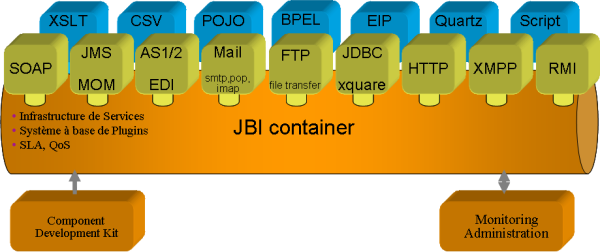
Partners
- eBM Websourcing, leader of the OW2 PEtALS project, and one originator of the JOnES project. eBM Websourcing is too committer of Eclipse STP project
- Ecole des Mines d’Albi-Carmaux is participating to the project as a research group working on collaborative processes modelling and definition on an SOA architecture based on ESB
- France Telecom R&D and its architecture/middleware/integrated services AMS group is expert in integration technologies and ESB
- INRIA participates with several teams : ADAM research project-team for complex distributed applications and transaction management, leader of JOTM, GoTM, FDF projects, SARDES research project-team for architecture for secure and adaptable large-scale distributed systems, leader of FRACTAL, DREAM projects and TUVALU (ex. OW@INRIA) development project-team for application-level integration, valorisation and project coordination, co-leader of STP-IM and of the Eclipse STP PMC (Project Management Committee), and one originator of the JOnES project
- Open Wide, one of the french Open Source integration specialists, and ledaer of the Eclipse JWT project, and one originator of the JOnES project
- ScalAgent Distributed Technologies, specialist in Data Mediation, leader of the JORAM project and one originator of the JOnES project
Main milestones and results
The JOnES project has achieved some main results:
- PEtALS V2.0, the European leader of the Open Source distributed ESB, September 30, 2008, shown in JavaPolis in Decembre 2007. More than 10000downlaods and one of the OW2 Top Ten projects
- PEtALS V2.1.1.1 has been certified according to the Sun JBI 1.0 TCK, March 2008
- JBI platform is supported by SCA-compliant development environment Eclipse STP
- INRIA DREAM canvas has been industrialized for the first time and integrated in PEtALS 2.0
- Creation review of the Eclipse JWT in January 2007, and a first JWT release (0.4) published in March 2008
- A detailed technological state-of-the-art describing ESB and SOA views, market analysis of some ESB products, standardisation section about JBI and SCA, and various usage scenarios
- From ObjectWeb to OW2 Consortium, January 2007
- Demonstrations and talks during Grand Colloque ANR/STIC events in October 2006 and November 2007
- Demonstrations and talks during Open Source (Solutions Linux, ObjectWeb/OW2 conferences and meetings, JavaPolis) and SOA/BPM events and conferences
- Extension of JOnES and SOA R&D activities through new projects : ANR SCOrWare, January 2007, SemEUsE, January 2008, FP7 NESSI SOA4ALL, March 2008
Project organisation
|
Work Package |
Title |
Lead |
Effort Person.Month |
| WP0 |
Project management, dissemination, standardisation |
INRIA Tuvalu | 26 |
| WP1 |
State of art, architecture, integration & packaging |
eBM websourcing | 31 |
| WP2 |
ESB internal framework binding components, naming, service container, JMX admin |
INRIA Sardes | 89 |
| WP3 |
ESB services and components routing, orchestration, transaction, QoS & SLA |
OpenWide | 41.5 |
| WP4 |
Usage demonstrators and valorisation |
FT R&D | 32 |
Project presentation
As shown during the “Grand Colloque 2007” in Paris, November 2007 (please have a look at the poster), the JOnES project has integrated several main activities. Advanced architectural works and developments have been done to build the JOnES ESB PEtALS internal bus fitting for distribution and high performance. A distributed and component-based architecture has been designed, based on the FRACTAL platform, the DREAM communication infrastructure and the FDF distributed deployment framework.
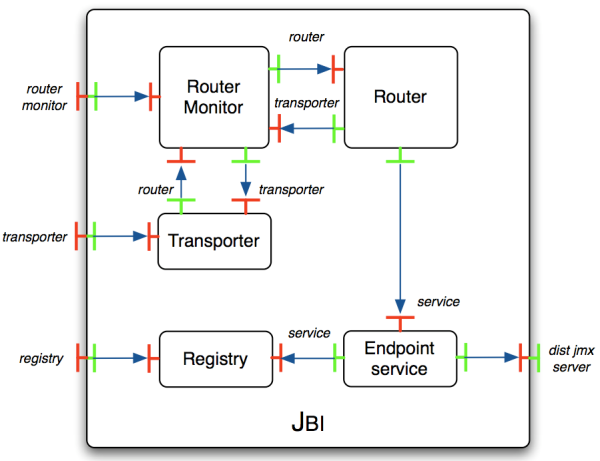
At application-level, developments done in the JOnES project enable alignment with SCA as a standard Service Component Architecture, and as a logical SOA specification. This work has been thought with relationships and collaboration with the ANR TL2006 SCOrWare project, and the Eclipse STP project and STP-IM sub-project.
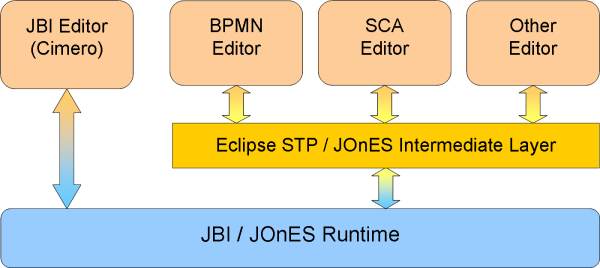
Various usage scenarios have been studied, describing the usage of an ESB in Telco applications (consumer-to-traffic management and monitoring), enterprise information integration, inter-enterprise collaborative business processes, and business services orchestration using BPEL.
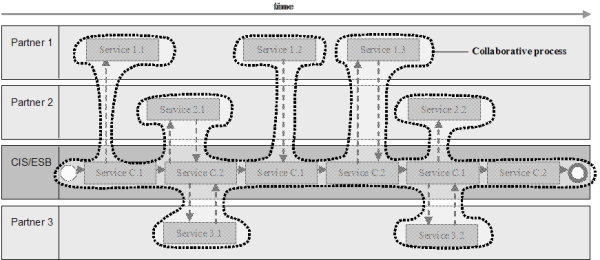
Finally, the JOnES project delivers an industrial grade ESB framework around PEtALS, the european distributed open source ESB. Numerous service engines and binding components are available : workflow based on Bonita, orchestration based on Orchestra, XML processing based on XQuare, EIP-based routing, JMS based on JORAM, Web Services, SOAP/http and ebXML.
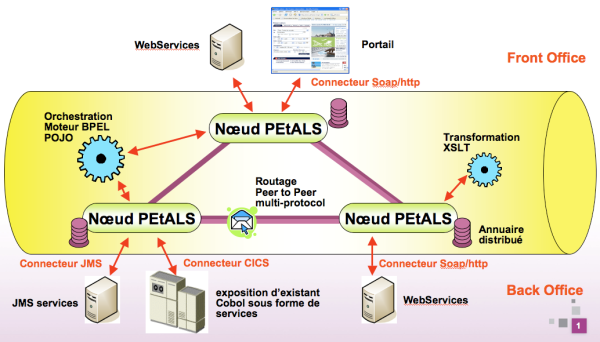
Interfaces with J2EE containers (JonAS, JBoss) are available too, and monitoring and management facilities have been developed, thanks to an advanced JMX-compliant monitoring console.
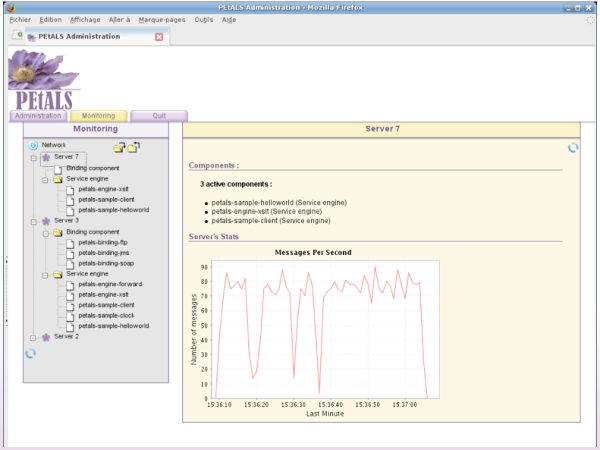
Main deliverables
Architecture & Requirements documents
Public Presentations
- "Grand Colloque STIC" poster, 2007
- PEtALS presentation by eBM websourcing at "Grand Colloque STIC", 2007
- JOnES presentation by FT R&D at "Grand Colloque STIC", 2007
Articles
- Choosing between Routing and Orchestration in an ESB by M. Dutoo (Open Wide) & A. Louis (eBM Websourcing)
ESB Open Canvas
- JORAM, integrated into PEtALS
- FDF, the Fractal Deployment Framework
- TMF (Thread management Framework) customized and integrated into PEtALS
- Fraclet, programming model for the Fractal component model, used for PEtALS
- JOTM (Java Open Transaction Manager), integrated into PEtALS
ESB Services and Components
Service Engine (SE) & Binding Components (BC)
The following components are downloadable as PEtALS SE or BC:
- Orchestra integrated into PEtALS as a SE
- Bonita workflow engine integrated into PEtALS as a SE
- EIP (Entreprise Integration Pattern) integrated into PEtALS as a SE
- BC-SOAP, offering support with WS Attachment, WS Notification and WS Security, integrated into PEtALS as a BC
- CSV support integrated into PEtALS as a SE
- XQuare, see below, integrated into PEtALS as a BC
XQuare
XQuare component allows database integration and XML queries (XQuery) in PEtALS. It is available in two versions:
- Open Wide implementation, well integrated to the latest PEtALS distributions, bringing a Binding-Component oriented vision (data insertion and emission)
- Odonata implementation, providing advanced functionalities with a Service-Engine oriented vision XML request engine), but less integrated to the lastest PEtALS distributions (no test performed after PEtALS 1.2 version, may 2007)
From a technical point of view, both rely on Odonata's OW2 XQuare library, and main differences between both versions are:
- XQuery module : both allow to perform XQuery request on a database. Additionally, Odonata implementation allows XQuery module (.mod) exposition as services through generated WSDLs, while Open Wide implementation allows to define parameterized stored queries. Finally, only Odonata implementation allows ESB service invocation and querying using XQuery, thanks to the XQuare Fusion library.
- Bridge module : both allow to insert data into a database. Additionally, Odonata implementation introduces a "Bridge module" notion allowing to simultaneously define insert and update operations within the same service configuration. Finally, only Open Wide implementation allows to listen for new data in the database and emit it, through a dedicated polling mechanism that detects new data according to a parameterized SQL query.
Here's an Odonata XQuare documentation explaining how to integrate and use its implementation with PEtALS JBI ESB.
Intermediate Meta-Model JBI/SCA
The STP Intermediate Metamodel source code is available from a SVN repository
See the STP-IM wiki for more information about this metamodel.
Use cases and usage demonstrators
PEtALS ESB demonstrators and tutorials (eBM webwourcing)
PEtALS ESB demonstrators are available in the PEtALS web site.
WorkFlow demonstrator (OpenWide)
WorkFlow demonstrator is available in the PEtALS web site.
Orchestration demonstrator (Tuvalu)
The TUVALU orchestration demonstrator aim is to show agility in Web-Services Orchestration using BPEL, through a travel booking scenario.
V1: Ochestrating simple Web-Services
This first version of the demonstrator shows a simple WS orchestration, without using an ESB.
Agility is demonstrated by changing a business rule, and easily propagating this change to the BPEL orchestration.
All you need to understand and run this demo is available in this archive.
V2: Integrating PEtALS ESB services into the orchestration
This second version improves the previous one by allowing orchestration of Services running on the PEtALS ESB, such as a mail service.
From v1 demonstrator, all you need to understand and run this demo is available in this archive.
V3: Full orchestration scenario inside PEtALS ESB
This last version renders enable direct WS orchestration inside the PEtALS ESB,
through the Orchestra Service Engine.
Moreover, it integrates many partners works, such a FDF for deployment,
or XQuare for data persistence.
All you need to understand and run this demo is available in this archive.
Contact
Feel free to contact us






